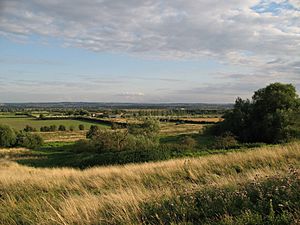Clopton, Cambridgeshire facts for kids
Quick facts for kids Clopton |
|
|---|---|

Site of Clopton village
|
|
| Location | Cambridgeshire, England |
| OS grid reference | TL303487 |
| Lua error in Module:Location_map at line 420: attempt to index field 'wikibase' (a nil value). | |
Clopton is a special place in Cambridgeshire, England. It used to be a busy village a long time ago, but now it's empty. People call it a "deserted medieval village" because it was left behind during the Middle Ages. You can find its old site about one mile southwest of Croydon, Cambridgeshire. It sits on a hill, which is how it got its name!
What Was Clopton?
Clopton was a village that existed for hundreds of years. It was built on a high ridge. This ridge gave the village its name, as 'Clopton' means 'town or settlement on a hill'.
A Look Back in Time
The history of Clopton goes back a very long way. Even during the time of the Romans, people lived in this area. By the 900s, an Anglo-Saxon village had grown there. It covered about 30 acres, which is like 22 football fields!
The village was important enough to be written about in the Domesday Book. This famous book was made in 1086 to record everything in England. It said that 18 peasants lived in Clopton. Later, in 1292, the village even got permission to hold a market every Friday.
Why Did Clopton Disappear?
Clopton became a "ghost village" in the early 1500s. This happened between 1500 and 1518. A rich lawyer from London named John Fisher bought the land in 1489. He then decided to make big changes.
John Fisher wanted to create large enclosures. This meant he fenced off the land for farming, especially for sheep. To do this, he made the villagers leave their homes. This sad event caused Clopton to become empty.
What Remains Today?
Even though the village is gone, its history is still there. Archaeologists have studied the site. They found where the old church of Saint Mary used to be. They also found two places that had moats, which are ditches filled with water. There was probably even an old mill nearby.
The church was in bad shape by 1561. Around that time, Clopton joined with the nearby village of Croydon. The old church was later taken down and the land was used for farming by 1660.
Today, the site of Clopton is a special protected area. It's called a Scheduled Ancient Monument. You can still see the earthworks, which are the bumps and hollows in the ground. These are the remains of the old village buildings and streets. They help us imagine what Clopton was like long ago.

